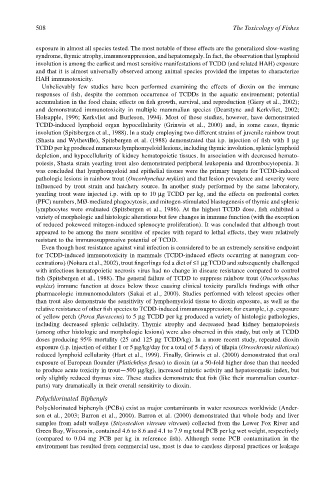Page 528 - The Toxicology of Fishes
P. 528
508 The Toxicology of Fishes
exposure in almost all species tested. The most notable of these effects are the generalized slow-wasting
syndrome, thymic atrophy, immunosuppression, and hepatomegaly. In fact, the observation that lymphoid
involution is among the earliest and most sensitive manifestations of TCDD (and related HAH) exposure
and that it is almost universally observed among animal species provided the impetus to characterize
HAH immunotoxicity.
Unbelievably few studies have been performed examining the effects of dioxin on the immune
responses of fish, despite the common occurrence of TCDDs in the aquatic environment; potential
accumulation in the food chain; effects on fish growth, survival, and reproduction (Giesy et al., 2002);
and demonstrated immunotoxicity in multiple mammalian species (Dearstyne and Kerkvliet, 2002;
Holsapple, 1996; Kerkvliet and Burleson, 1994). Most of those studies, however, have demonstrated
TCDD-induced lymphoid organ hypocellularity (Grinwis et al., 2000) and, in some cases, thymic
involution (Spitsbergen et al., 1988). In a study employing two different strains of juvenile rainbow trout
(Shasta and Wytheville), Spitsbergen et al. (1988) demonstrated that i.p. injection of fish with 1 µg
TCDD per kg produced numerous lymphomyeloid lesions, including thymic involution, splenic lymphoid
depletion, and hypocellularity of kidney hematopoietic tissues. In association with decreased hemato-
poiesis, Shasta strain yearling trout also demonstrated peripheral leukopenia and thrombocytopenia. It
was concluded that lymphomyeloid and epithelial tissues were the primary targets for TCDD-induced
pathologic lesions in rainbow trout (Oncorhynchus mykiss) and that lesion prevalence and severity were
influenced by trout strain and hatchery source. In another study performed by the same laboratory,
yearling trout were injected i.p. with up to 10 µg TCDD per kg, and the effects on prefrontal cortex
(PFC) numbers, MØ-mediated phagocytosis, and mitogen-stimulated blastogenesis of thymic and splenic
lymphocytes were evaluated (Spitsbergen et al., 1986). At the highest TCDD dose, fish exhibited a
variety of morphologic and histologic alterations but few changes in immune function (with the exception
of reduced pokeweed mitogen-induced splenocyte proliferation). It was concluded that although trout
appeared to be among the more sensitive of species with regard to lethal effects, they were relatively
resistant to the immunosuppressive potential of TCDD.
Even though host resistance against viral infection is considered to be an extremely sensitive endpoint
for TCDD-induced immunotoxicity in mammals (TCDD-induced effects occurring at nanogram con-
centrations) (Nohara et al., 2002), trout fingerlings fed a diet of ≤1 µg TCDD and subsequently challenged
with infectious hematopoietic necrosis virus had no change in disease resistance compared to control
fish (Spitsbergen et al., 1988). The general failure of TCDD to suppress rainbow trout (Oncorhynchus
mykiss) immune function at doses below those causing clinical toxicity parallels findings with other
pharmacologic immunomodulators (Sakai et al., 2000). Studies performed with teleost species other
than trout also demonstrate the sensitivity of lymphomyeloid tissue to dioxin exposure, as well as the
relative resistance of other fish species to TCDD-induced immunosuppression; for example, i.p. exposure
of yellow perch (Perca flavescens) to 5 µg TCDD per kg produced a variety of histologic pathologies,
including decreased splenic cellularity. Thymic atrophy and decreased head kidney hematopoiesis
(among other histologic and morphologic lesions) were also observed in this study, but only at TCDD
doses producing 95% mortality (25 and 125 µg TCDD/kg). In a more recent study, repeated dioxin
exposure (i.p. injection of either 1 or 5 µg/kg/day for a total of 5 days) of tilapia (Oreochromis niloticus)
reduced lymphoid cellularity (Hart et al., 1999). Finally, Grinwis et al. (2000) demonstrated that oral
exposure of European flounder (Platichthys flesus) to dioxin (at a 50-fold higher dose than that needed
to produce acute toxicity in trout—500 µg/kg), increased mitotic activity and hepatosomatic index, but
only slightly reduced thymus size. These studies demonstrate that fish (like their mammalian counter-
parts) vary dramatically in their overall sensitivity to dioxin.
Polychlorinated Biphenyls
Polychlorinated biphenyls (PCBs) exist as major contaminants in water resources worldwide (Ander-
son et al., 2003; Barron et al., 2000). Barron et al. (2000) demonstrated that whole body and liver
samples from adult walleye (Stizostedion vitreum vitreum) collected from the Lower Fox River and
Green Bay, Wisconsin, contained 4.6 to 8.6 and 4.1 to 7.9 mg total PCB per kg wet weight, respectively
(compared to 0.04 mg PCB per kg in reference fish). Although some PCB contamination in the
environment has resulted from commercial use, most is due to careless disposal practices or leakage

